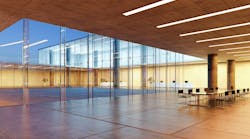Durham, N.C.-based Cree, Inc. recently announced that Arizona State University (ASU), Mesa, Ariz., has joined the Cree LED University program, an international community of universities working to accelerate the adoption of energy-efficient LEDs across their campuses. ASU has equipped six parking structures with more than 2,000 LED fixtures and has replaced 6-in. incandescent downlights in the Sandra Day O'Connor School of Law rotunda with energy-efficient LED downlights.
"LED lighting is another proof point for our ongoing green efforts, " says Bonny Bentzin, director of sustainable business practices at ASU. "Installing LED fixtures on campus provides an energy-efficient means to achieve higher quality of light, as well as offering financial benefits due to the associated energy and maintenance savings. "
A university of approximately 80,000 students, faculty and staff, ASU has continued to excel at energy conservation and sustainability programs, including the installation of LED lighting solutions across its campus. For the second year in a row, ASU was named one of the nation's "greenest" universities by The Princeton Review in its Green Rating Honor Roll, an annual rating of environmentally friendly institutions.
Working with Tempe, Ariz.-based APS Energy Services, ASU replaced more than 2,000 150W metal-halide fixtures with 78W LED low-bay luminaires in six parking structures. By replacing the existing metal-halide fixtures and lamps, ASU anticipates reducing energy consumption by 1.5 million kilowatt hours per year, which can be compared to the annual greenhouse gas emissions from 208 passenger vehicles. The move to LEDs could deliver annual savings of up to $127,000 in energy and maintenance costs, and the new fixtures are projected to last 50,000 hours, or approximately three times longer than a typical metal-halide bulb.
The Cree LR6 recessed downlights in the Sandra Day O'Connor School of Law rotunda consume 85% less energy than the incandescent fixtures they replaced, and are designed to last 50,000 hours, compared to approximately 1,000 hours for an incandescent bulb.
"By installing energy-efficient LED lighting, ASU is continuing to pursue sustainability efforts across its campus, " says Deb Lovig, LED programs manager at Cree. "Not only is it promoting environmentally conscious projects, but it is also helping to instill these principles in its students and lead other universities by example. "


